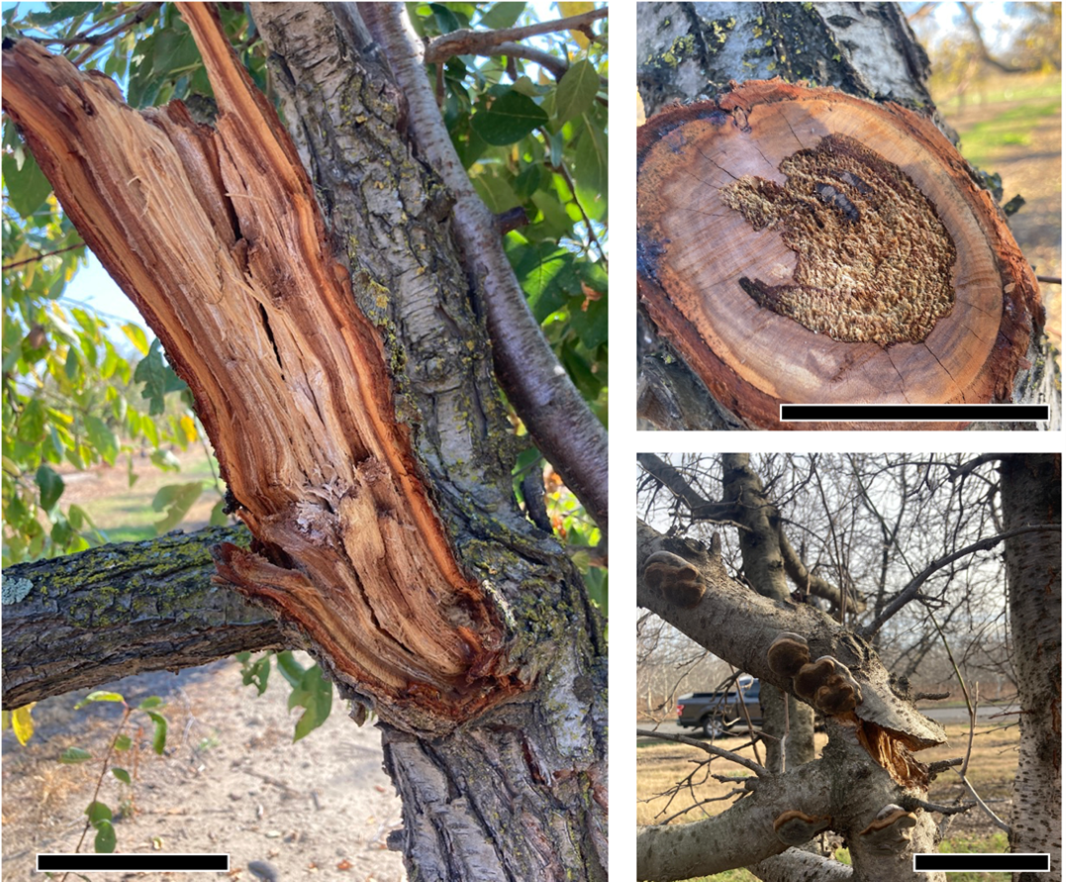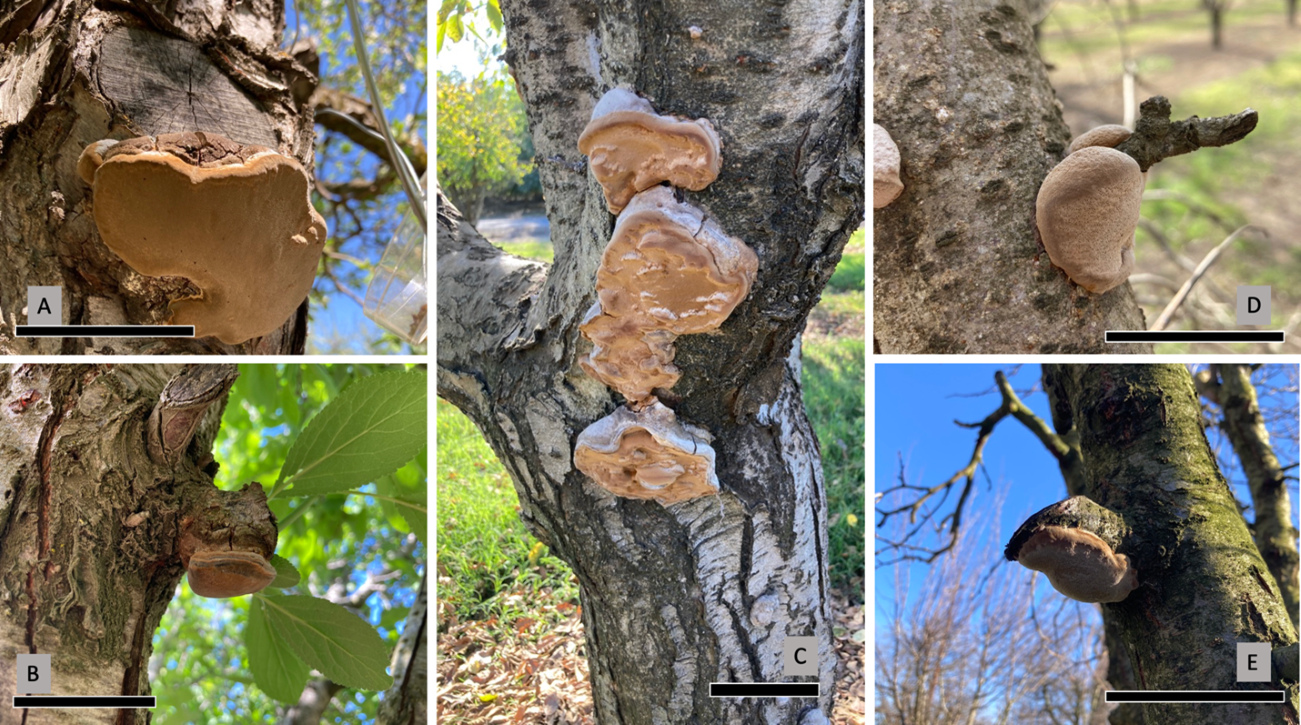Laurel Hoffman, UC Davis Dept. of Plant Pathology PhD Graduate Student, Rizzo Lab
California’s prune industry faces a significant challenge: a decline in orchard lifespan. Average productive life has shrunk from an estimated 30 years in 1998 to just 20 years as of 2022 (UC Cost and Return Studies). Heat stress, repeated mechanical damage, and disease are likely contributing factors. A primary disease culprit associated with premature orchard decline is the loss of fruit-producing scaffolds likely caused by the heart rot fungus Phellinus pomaceus (formerly called P. tuberculosus).
Phellinus pomaceus specifically targets Prunus spp., unlike most wood decay fungi which have a broader host range. This fungus is common in natural forests of Europe and Asia. It invades the heartwood, causing white rot that weakens branches. In California prune trees, this results in broken branches that reduce fruit production. Additionally, weakened trees become more susceptible to other stressors, ultimately shortening orchard lifespan.
Prune growers should be aware of the signs of Phellinus pomaceus infection. Look for shelf-like fruiting bodies (conks) on trunks or branches (see photos below) – these are the fungus’ reproductive structures and indicate established infection. Additionally, broken or pruned branches with exposed white rot decay (also pictured below) can indicate the disease. Growers often discover this internal heart rot in major scaffolds leading up to and during harvest, when branches that appear healthy snap under the weight of fruit or during shaking– aka “blowing up.”
Our research in investigating Phellinus pomaceus and developing management strategies is supported by funding from the California Prune Board. We are focused on investigating several key areas:
Distribution of the fungus, its impacts, and management choices: We are surveying prune orchards to assess the prevalence and severity of infection statewide and investigating potential links between disease occurrence and factors like pruning practices, irrigation types, spray applications of dormant oils, the presence of other pathogens, and local weather conditions. Surveys in mature prune orchards reveal a high prevalence of Phellinus pomaceus infection levels in the Sacramento Valley compared to historical studies, with all surveyed contemporary orchards over 14 years showing signs of the infection. Conversely, extremely limited infection has been observed so far in the San Joaquin Valley. Weather stations have been installed in 10 orchards from Red Bluff to Madera since Fall 2023 and provide specific in-orchard conditions that may be related to the progression of the disease.
Additionally, we are collaborating with researchers in France and South America to see if Phellinus pomaceus is a problem in other major prune-producing regions. Surveys in Chilean prune orchards are planned for September 2024 with additional funding from UC Davis Chile Life Sciences Institute.
Potential Control Methods: Since there is currently no known chemical control for Phellinus pomaceus, we are exploring bio-control alternatives. Two trials are underway to investigate the potential of Trichoderma spp. (a beneficial fungus used as a bio-control product in other crops, one trade name is Vintec®), to protect pruning wounds from Phellinus pomaceus infection. The first trial is a multi-year project (started in 2020) wherein orchard blocks have been sprayed with Trichoderma products annually and disease progress is being monitored. Due to the slow progression of this disease, results will not be clear for many more years. The second trial is direct application on fruiting bodies to observe any effects on growth and spore production. After a single season in this trial, unfortunately Phellinus appears unhampered in its life cycle – though these results are still pending. A third trial is upcoming and will consist of targeted pre-inoculation of fresh pruning wounds with different combinations of Phellinus pomaceus spores and Trichoderma bio-controls and re-sampling a short time later to observe disease progression in the presence of these alternative spray applications.
Spore Dispersal and infection routes: Understanding the life cycle of fungal pathogens is crucial for disease prevention, though current literature is lacking in relevant studies on Phellinus pomaceus. We are working to understand how the disease colonizes and spreads in California prune orchards. Recent dissection of infected trees indicates the primary route of infection is through pruning wounds, which are colonized by airborne spores released by the fungus during specific windows.
We are monitoring airborne fungal spores in orchards throughout the year to identify these peak periods of Phellinus pomaceus spore dispersal. This information can help growers time pruning activities to minimize infection risk. Initial results show peak spore production in late January to early April, depending on the region. These data currently support orchard managers to avoid pruning during this time, when chances of infection are likely highest. More official data will be coming in the next year.

Figure 1. Fruiting body of Phellinus pomaceus. Characteristic association with pruning wounds shown in A, B, D, E. Scale bars 10 cm (4 inches).

Figure 2: Symptoms of advanced Phellinus pomaceus infection, showing white rot internal decay of heartwood. Scale bars 10 cm (4 inches).
We will continue to share our findings and develop management recommendations for growers. Stay tuned for future updates on the completion of orchard surveys and the impacts of orchard management practices, the results of Trichoderma spp. trials, and how our growing understanding of the life cycle of Phellinus can improve management of the disease. We are grateful to the California Prune Board for generously funding this important research.
Please reach out to Laurel Hoffman, PhD Graduate Student in the lab of Dr. David Rizzo of the UC Davis Dept. of Plant Pathology if you have concerns or questions about this research at Hoffman@ucdavis.edu.


Leave a Reply